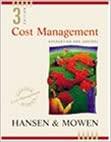Gateway Construction Company is a family-operated business founded in 1970 by Samuel Gateway. In the beginning, the
Question:
Gateway Construction Company is a family-operated business founded in 1970 by Samuel Gateway. In the beginning, the company consisted of Gateway and three employees laying gas, water, and sewage pipelines as subcontractors. Currently, the company employs twentyfive to thirty people and is directed by Jack Gateway, Samuel's son. The main line of busi¬
ness continues to be laying pipeline.
Most of Gateway's work comes from contracts with city and state agencies. All of the company's work is located in the state of Nebraska. The company's sales volume averages
$3 million, and profits vary between 0 and 10 percent of sales.
Sales and profits have been somewhat below average for the past three years due to a recession and intense competition. Because of this competition. Jack Gateway is constantly reviewing the prices bid by other companies for jobs. When a bid is lost, he makes every at¬
tempt to analyze the reasons for the differences between his bid and that of his competitors.
He uses this information to increase the competitiveness of future bids.
Jack has become convinced that Gateway's current accounting system is deficient. Cur¬
rently, all expenses are simply deducted from revenues to arrive at net income. No effort is made to distinguish among the costs of laying pipe, obtaining contracts, and administering the company. Yet all bids are based on the costs of laying pipe.
Jack also knows that knowledge of cost behavior is important. He is certain that the company could offer more competitive bids if he knew which costs were variable and which were fixed. For example. Gateway often has idle equipment. (The company needs more equipment than is often necessary so that it can bid on larger projects.) If Gateway could bid enough to cover its variable costs and use the idle equipment, equipment operators could be more productively utilized and have more job stability. In fact, if the bid covered more than variable costs, profits would increase as well, since the fixed costs remain unchanged for increased activity.
With these thoughts in mind. Jack began a careful review of the income statement for the previous year (shown below). First, he noted that jobs were priced on the basis of equip¬
ment hours, with an average price of $165 per equipment hour. However, when it came to classifying costs and identifying their behavior, he decided that he needed some help. One thing that really puzzled him was how to classify his own salary of $114,000. About half of his time was spent in bidding and securing contracts, and the other half was spent in gen¬
eral administrative matters.

Required:
1. Classify the costs shown in the income statement as: (1) costs of laying pipe (production costs); (2) costs of securing contracts (selling costs); and (3) costs of general administra¬
tion. For production costs, identify direct materials, direct labor, and overhead costs. The company never has significant work in process (most jobs are started and completed within a day).
2. Using the functional classification developed in Requirement 1, prepare an absorption¬
costing income statement. What is the average cost per equipment hour for laying pipe?
3. Suppose that Jack has idle equipment and wants to prepare a bid for a prospective job.
Assume that the only significant activity driver is equipment hours. He is confident that a bid of $140 will win the job. Using your knowledge of product/service cost defini¬
tions, help him with the bidding decision.
Step by Step Answer:

Cost Management Accounting And Control
ISBN: 9780324002324
3rd Edition
Authors: Don R. Hansen, Maryanne M. Mowen





